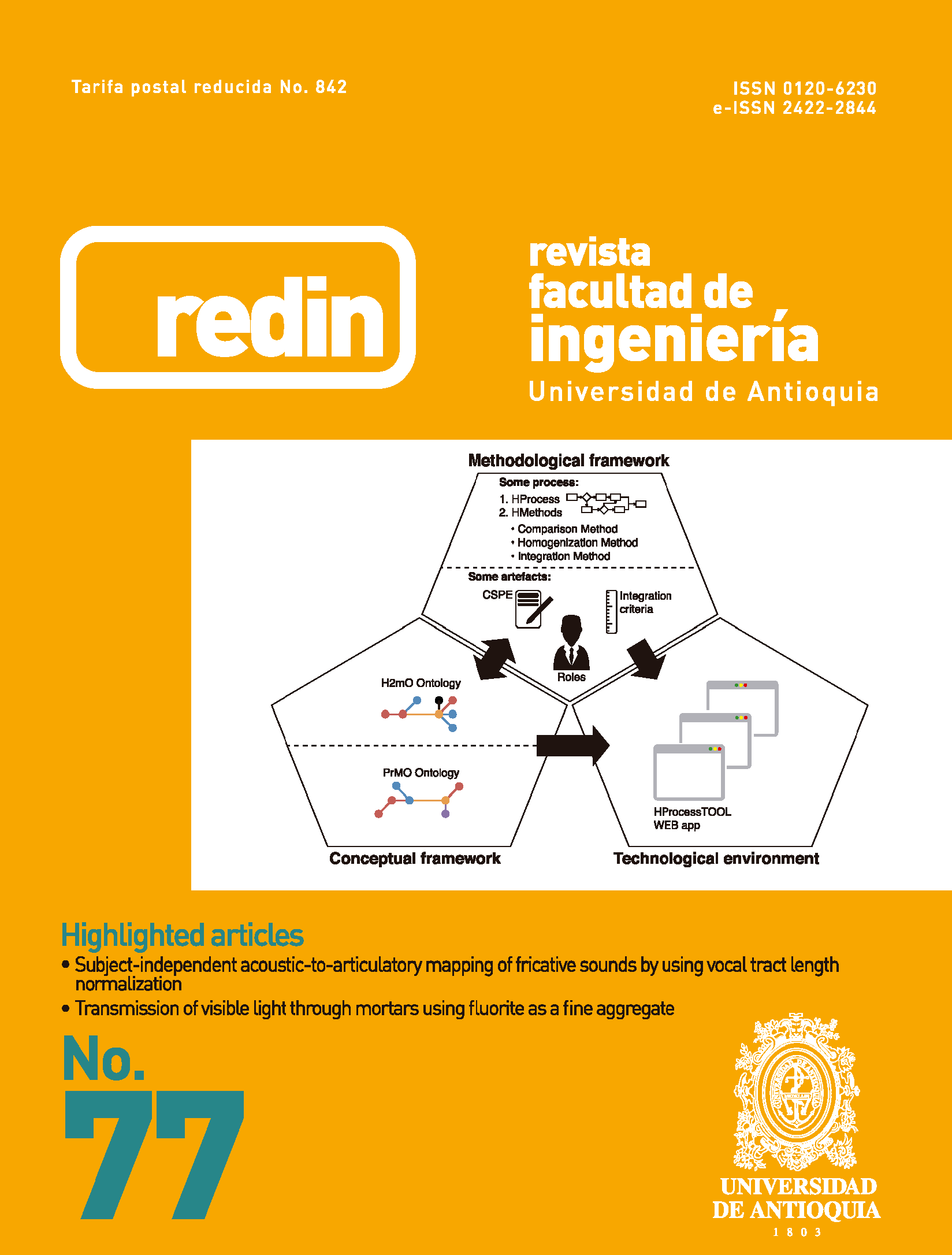Transmisión de luz visible a través de morteros con fluorita como agregado fino
DOI:
https://doi.org/10.17533/udea.redin.n77a06Palabras clave:
propiedades ópticas en morteros, transmitancia en morteros, morteros translúcidosResumen
En este artículo se presentan los resultados de la evaluación de las propiedades ópticas, en el intervalo de luz visible, en morteros de cemento Pórtland blanco y gris a partir de ocho variables controlables: tamaño del agregado, tipo de cemento, relación agua-cemento, tipo de agregado, relación cemento-agregado, espesor del mortero, porcentaje de aire incluido y porcentaje de fibra óptica. Se definió la modelación matemática que permitió identificar el comportamiento de un haz de luz a medida que atraviesa los morteros. Se midieron tres propiedades: reflexión, absorción y transmitancia. Se utilizó un espectrofotómetro y dos fuentes de luz. De las ocho variables controlables el espesor, el tamaño del agregado y el tipo de cemento son las de mayor incidencia sobre la transmitancia.
Descargas
Citas
M. Abou, E. Fahmy and D. Abou, “Properties of Translucent Concrete”, in Annual Conference of the Canadian Society for Civil Engineering, Yellowknife, Canada, 2007, pp. 651-660.
R. Edmeades and P. Hewlett, “Cement admixtures”, in Lea’s Chemistry of Cement and Concrete, 4th ed., P. Hewlett (ed), Oxford, England: ButterworthHeinemann, 2003, pp. 841-905.
Z. Zhou, G. Ou, Y. Hang, G. Chen and J. Ou, “Research and development of plastic optical fiber based smart transparent concrete”, in SPIE 7293, Smart Sensor Phenomena, Technology, Networks, and Systems, San Diego, USA, 2009, pp. 1-6.
J. Gutiérrez, S. Galvan and G. Aviles, “Diseño de un Concreto Translucido”, in 3rd Congreso Internacional de Materiales - Simposio Materia, Cartagena, Colombia, 2005, pp. 1-10.
J. Gutiérrez and S. Cazares, “Formulation for obtaining a translucent concrete mixture”, U.S. Patent 20090298972 A1, Dic. 3, 2009.
A. Losonczi, “Translucent building block and a method for manufacturing the same”, U.S. Patent 8091303 B2, Jan. 10, 2012.
A. Losonczi, “Building block comprising light transmitting fibres and a method for producing the same”, U.S. Patent 20050183372 A1, Aug. 21, 2005.
A. Momin, R. Kadiranaikar, V. Jagirdar and A. Ahemed, “Study on Light Transmittance of Concrete Using Optical Fibers and Glass Rods”, in International Conference on Advances in Engineering & Technology (ICAET), India, 2014, pp. 67-72.
M. Padma, D. Johnson, A. Basheer and K. Prasanthi, “Optical Fibres in the Modeling of Translucent Concrete Blocks”, International Journal of Engineering Research and Applications, vol. 3, no. 3, pp. 13-17, 2013.
S. Paul and A. Dutta, “Translucent Concrete”, International Journal of Scientific and Research Publications, vol 3, no. 10, pp. 1-10, 2013.
A. Mainini, T. Poli, M. Zinzi and S. Cangiano, “Spectral light transmission measure and radiance model validation of an innovative transparent concrete panel for façades”, Energy Procedia, vol. 30, pp. 1184-1194, 2012.
B. Kashiyani, V. Raina, J. Pitroda and B. Shah, “A Study on Transparent Concrete: A Novel Architectural Material to Explore Construction Sector”, International Journal of Engineering and Innovative Technology, vol. 2, no. 8, 2013, pp. 83-87.
J. Halm“Method for producing moulded bricks with fibres”, U.S. Patent 20090200703 A1, Aug. 13, 2009.
C. Wert and R. Thomson, “Physics of solids”, 2nd ed. New York, USA: Mc Graw-Hill, 1967.
E. Dana, “A tex-book of Mineralogy”, in Dana´s Series of Mineralogies, 3rd ed., E. Dana and W. Ford (eds). New York, USA: John Wiley & Sons, Inc., 1922, pp. 279-314.
M. Cánovas, Hormigón, 8th ed. Madrid, Spain: Colegio de Ingeniería de Caminos, Canales y Puertos, 2007. pp. 666.
D. Montgomery, Design and Analysis of experiments, 5th ed. John Wiley & Sons, Inc., 2001.
J. Fernandez, El Vidrio, 2nd ed. Madrid, Spain: Concejo Superior de Investigaciones Científicas, 1991. pp. 452- 554.
Descargas
Publicado
Cómo citar
Número
Sección
Licencia
Derechos de autor 2015 Revista Facultad de Ingeniería Universidad de Antioquia

Esta obra está bajo una licencia internacional Creative Commons Atribución-NoComercial-CompartirIgual 4.0.
Los artículos disponibles en la Revista Facultad de Ingeniería, Universidad de Antioquia están bajo la licencia Creative Commons Attribution BY-NC-SA 4.0.
Eres libre de:
Compartir — copiar y redistribuir el material en cualquier medio o formato
Adaptar : remezclar, transformar y construir sobre el material.
Bajo los siguientes términos:
Reconocimiento : debe otorgar el crédito correspondiente , proporcionar un enlace a la licencia e indicar si se realizaron cambios . Puede hacerlo de cualquier manera razonable, pero no de ninguna manera que sugiera que el licenciante lo respalda a usted o su uso.
No comercial : no puede utilizar el material con fines comerciales .
Compartir igual : si remezcla, transforma o construye a partir del material, debe distribuir sus contribuciones bajo la misma licencia que el original.
El material publicado por la revista puede ser distribuido, copiado y exhibido por terceros si se dan los respectivos créditos a la revista, sin ningún costo. No se puede obtener ningún beneficio comercial y las obras derivadas tienen que estar bajo los mismos términos de licencia que el trabajo original.










 Twitter
Twitter